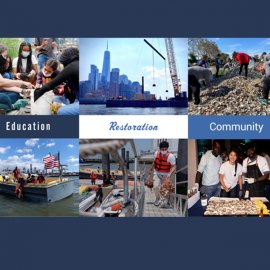Billion Oyster Project
-
English
-
ListenPause
I’m Peter Neill, Director of the World Ocean Observatory. When one thinks of oysters, one may think of Rockefeller and champagne, as a kind of shellfish metaphor for wealth and extravagance. But there was a time, not so long ago, when the oyster was poor man’s subsistence food, cheap, available and plentiful, and eaten more often than not because one could not afford anything else. Native peoples thrived on oysters, and working class people ate oysters and crackers by the bucket-load with beer as a cheap repast. New York Harbor and the surrounding wetlands of New Jersey were once prime ground for oysters and the notorious Fulton Fish Market was piled with many varieties either local or imported from the waters further north in New England or further south in the Chesapeake Bay. The oyster shells were recycled, gathered and redistributed to coastal areas where the spat or seed took hold and began to grow another oyster in a perpetual natural cycle of sustainable plenty. But whether as an accompaniment to champagne or beer, the certain supply suddenly dwindled as the coastal, brackish water where the oysters lay became polluted with waste water and chemicals and oil residue and poisons that destroyed the seed grounds and beds, the supply and demand for a marine food that had suddenly lost its viability and market. The water in New York Harbor and the surrounding rivers and streams was simply filthy; no one would drink it, no one would swim in it, and certainly no one would consume shellfish that had been immersed in its toxic flow. It seemed possible that an ensuing generation might not ever know what an oyster was or its exquisite salty taste. In the 1970s, when environmental awareness began to take hold in the Untied States, the public, through legislation like the Clean Air Act or Clean Water Act, demanded a new attitude toward water for drinking and health rather than for industrial use or sanitation. Conservation, management, purification, treatment, legislation, and enforcement – all were applied to raise public awareness, to demand changed behaviors, and to expect some semblance of clarity and cleanliness in their drinking water and watersheds. But no one expected that New York could change, just as no one expected that the smog-infested air of the industrial Midwest could change either – and yet both did as a result of political will and responsive governance. Today, in New York Harbor, an innovative, theme-based high school, funded by the William and Melissa Gates and other progressive foundations, saw the opportunity to organize its curriculum around maritime history, marine science, and marine vocational skills as a context for teaching and learning that was authentic, experiential, and inspiring. The school was first hosted in the South Street Seaport Museum in Lower Manhattan, grew and moved to Brooklyn, and then became the central educational activity on Governor’s Island, the former U.S. Coast Guard headquarters in New York Harbor. Called The Harbor School, this educational experiment has now proven its value, growing in size and stature, and placing its graduates in jobs, often marine-related, as well as college and the maritime academies in the United States and elsewhere. As a challenge to its purpose both as an educational and community institution, the Harbor School invented the Billion Oyster Project, an ecosystem services initiative of the New York Harbor Foundation, that would engage its students in a hands-on activity to reconnect the harbor to the 30 million people living within its vast urban watershed. The students would exploit the new cleanliness of the water by reviving the defunct oyster populations through the ambitious goal of restoring no less than one BILLION oysters to the Harbor. And so they have begun through aquaculture study, seeding and growing, restaurant promotions, shell recycling, featured markets, summer camps, fundraising events, and volunteer efforts, involving to date over 3000 students and planting some 16 million oysters for ecosystem services since the project began in the polluted Gowanus Canal in 2006. As a community organization, an educational experiment, and an expression of new sustainability-based values that will guarantee restoration and survival of this and other important sources of marine protein, the Harbor School demonstrates how learning can be effective and useful and how “citizens of the ocean” of any age can join together in Nature to build better lives for ourselves and better places to live alongshore. We will discuss these issues, and more, in future editions of World Ocean Radio. - - - WORLD OCEAN RADIO IS A PROJECT OF THE WORLD OCEAN OBSERVATORY, IN ASSOCIATION WITH WERU-FM, BLUE HILL, MAINE. FIND OUR PODCAST ON ITUNES AND AT WORLD OCEAN OBSERVATORY DOT ORG.
This summer we are revisiting some of our favorite World Ocean episodes that highlight optimism in ocean news, science and advocacy. In this episode we're talking about the history of oysters, New York Harbor, and the Harbor School—an innovative high school on Governor’s Island in New York City, highlighting their Billion Oyster Project, designed to revive the defunct oyster populations through an ambitious goal of restoring no less than one billion oysters to New York harbor. Harbor School's restorative ecosystem service activities are reconnecting the harbor to the 30 million people living within its vast urban watershed.
About World Ocean Radio
World Ocean Radio provides coverage of a broad spectrum of ocean issues from science and education to advocacy and exemplary projects; it is a weekly series of five-minute audio essays available for syndicated use at no cost by college and community radio stations worldwide.
Resources
Billion Oyster Project
billionoysterproject.org
Clean Air Act (1975)
epa.gov/laws-regulations/summary-clean-air-act
Clean Water Act (1948 w/sweeping amendments in 1972)
epa.gov/laws-regulations/history-clean-water-act
Image Credit
from the Billion Oyster Project 2021 Annual Report
visit billionoysterproject.org/financials
- Login to post comments



